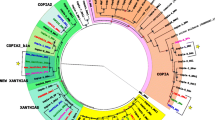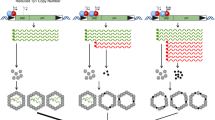Abstract
Drosophila melanogaster retrotransposons of the gypsy group are considered to be potential errantiviruses. Their infectivity is caused by the functional activity of the third open reading frame (ORF3) encoding the Env protein, which was probably captured from baculoviruses. Mobile genetic elements (MGEs) of the gypsy group can be conventionally divided into three subgroups: with three ORFs, with a defective ORF3, and without the ORF3. To establish the patterns of evolution of gypsy retrotransposons in D. melanogaster, the members of the three subgroups were examined. Structural analysis of retrotransposons opus and rover, which carry a defective ORF3, as well as retrotransposons Burdock, McClintock, qbert, and HMS-Beagle, which lack the ORF3, suggests that the evolution of these MGEs followed the pattern of loosing the ORF3. At the same time, an MGE of the same subgroup, Transpac, may be an ancestral form, which had acquired the env gene and gave rise to the first errantiviruses. The capture of the ORF3 by retrotransposons provided their conversion to a fundamentally new state. However, the ORF3 in the genome is not subjected to strong selective pressure, because it is not essential for intragenomic transpositions. Because of this, the process of its gradual loss seems quite natural.
Similar content being viewed by others
References
Hardman, N., Structure and Function of Repetitive DNA in Eukaryotes, Biochem. J., 1986, vol. 234, no. 1, pp. 1–11.
Temin, H.M., Origin of Retroviruses from Cellular Moveable Genetic Elements, Cell, 1980, vol. 21, no. 3, pp. 599–600.
Flavell, A.J., Retroelements, Reverse Transcriptase and Evolution, Comp. Biochem. Physiol. B. Biochem. Mol. Biol., 1995, vol. 110, no. 1, pp. 3–15.
Song, S.U., Kurkulos, M., Boeke, J.D., and Corces, V.G., Infection of the Germ Line by Retroviral Particles Produced in the Follicle Cells: A Possible Mechanism for the Mobilization of the gypsy Retroelement of Drosophila, Development, 1997, vol. 124, no. 14, pp. 2789–2798.
Kim, A.I., Lyubomirskaya, N.V., Belyaeva, E.S., et al., The Introduction of Transposionally Active Copy of a Retrotransposon gypsy into the Stable Strain of Drosophila melanogaster, Mol. Gen. Genet., 1994, vol. 242, no. 4, pp. 472–477.
Leblanc, P., Desset, S., Giorgi, F., et al., Life Cycle of an Endogenous Retrovirus, ZAM, in Drosophila melanogaster, J. Virol., 2000, vol. 74, no. 22, pp. 10658–10669.
Boeke, J.D., Eickbush, T.H., Sandmeyer, S.B., and Voytas, D.F., Virus Taxonomy: ICTV VIIth Report, New York: Springer, 2000.
Lerat, E. and Capy, P., Retrotransposons and Retroviruses: Analysis of the Envelope Gene, Mol. Biol. Evol., 1999, vol. 16, no. 9, pp. 1198–1207.
Laten, H.M., Havecker, E.R., Farmer, L.M., and Voytas, D.F., SIRE1, an Endogenous Retrovirus Family from Glycine max, Is Highly Homogeneous and Evolutionarily Young, Mol. Biol. Evol., 2003, vol. 20, no. 8, pp. 1222–1230.
Kaminker, J.S., Bergman, C.M., Kronmiller, B., et al., The Transposable Elements of the Drosophila melanogaster Euchromatin: a Genomics Perspective, Genome Biol., 2002, vol. 3, no. 12, RESEARCH0084.
Coffin, J.M., Hughes, S.H., and Varmus, H.E., Retroviruses: Plainview, New York: Cold Spring Harbor Lab., 1997.
Terzian, C., Pelisson, A., and Bucheton, A., Evolution and Phylogeny of Insect Endogenous Retroviruses, BMC Evol. Biol., 2001, vol. 1, p. 3.
Thompson, J.D., Plewniak, F., and Poch, O., A Comprehensive Comparison of Multiple Sequence Alignment Programs, Nucleic Acids Res., 1999, vol. 27, nos. 1–3, pp. 2682–2690.
Malik, H.S., Henikoff, S., and Eickbush, T.H., Poised for Contagion: Evolutionary Origins of the Infectious Abilities of Invertebrate Retroviruses, Genome Res., 2000, vol. 10, no. 9, pp. 1307–1318.
Mejlumian, L., Pelisson, A., Bucheton, A., and Terzian, C., Comparative and Functional Studies of Drosophila Species Invasion by the gypsy Endogenous Retrovirus, Genetics, 2002, vol. 160, no. 1, pp. 201–209.
Kim, A.I., MDG4 (gypsy) Drosophila melanogaster Endoparasite: Regulation of Transposition and Infectivity, in Medical Parasitology and Parasitic Diseases, 2007 (in press).
Nefedova, L.N. and Kim, A.I., Evolution of Drosophila melanogaster Errantiviruses: From Retrotransposons to Retroviruses, Zh. Obshch. Biol., 2007 (in press).
Author information
Authors and Affiliations
Corresponding author
Additional information
Original Russian Text © L.N. Nefedova, A.I. Kim, 2007, published in Genetika, 2007, Vol. 43, No. 10, pp. 1388–1395.
Rights and permissions
About this article
Cite this article
Nefedova, L.N., Kim, A.I. Evolution of errantiviruses of Drosophila melanogaster. Strategy 2: From retroviruses to retrotransposons. Russ J Genet 43, 1161–1167 (2007). https://doi.org/10.1134/S1022795407100109
Received:
Issue Date:
DOI: https://doi.org/10.1134/S1022795407100109




